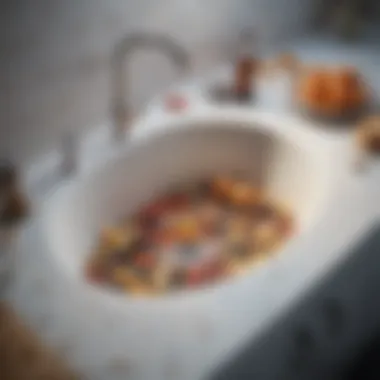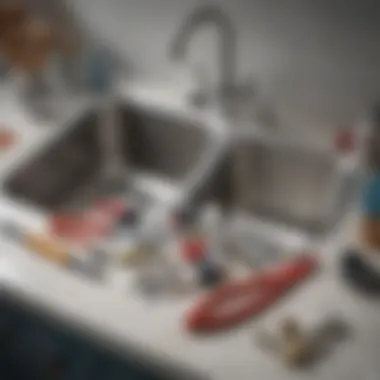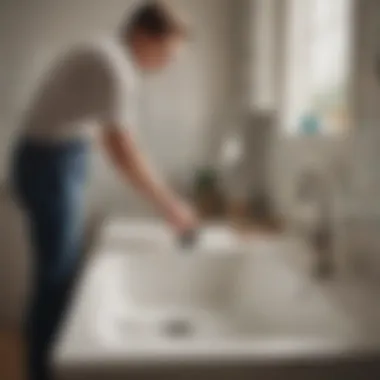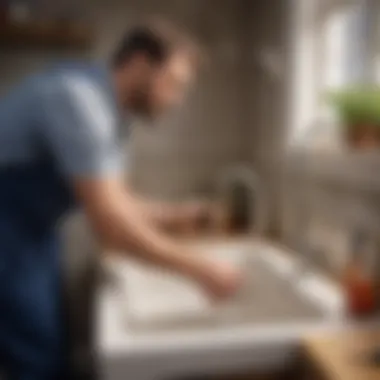Expert Plumbing Solutions for Dealing with a Clogged Sink at Home


The nuisance of a clogged sink is a common occurrence in households, often leading to frustration and inconvenience. This comprehensive guide delves into practical plumbing solutions to effectively tackle and prevent sink blockages. From understanding the underlying causes of clogs to exploring do-it-yourself remedies and professional interventions, readers will acquire valuable insights to address this prevalent issue.
Understanding Sink Blockages
Before delving into solutions, it is crucial to grasp the causes of sink blockages. Factors such as grease buildup, food particles, hair, and soap residue contribute to the obstruction of pipes, leading to slow drainage or complete blockage. By understanding these common culprits, homeowners can implement preventive measures to mitigate the occurrence of clogs.
DIY Remedies for Sink Clogs
When faced with a clogged sink, there are several DIY remedies that individuals can employ to restore proper drainage. Simple techniques such as using a plunger, creating a vinegar and baking soda mixture, or utilizing a plumber's snake can help dislodge minor clogs. These cost-effective solutions offer a quick and convenient way to address the issue without the need for professional assistance.
Professional Interventions for Stubborn Clogs
In cases where DIY methods prove ineffective or for more severe clogs, seeking professional plumbing assistance is advisable. Experienced plumbers possess the expertise and tools necessary to diagnose and resolve complex sink blockages efficiently. Through methods such as hydro-jetting or snaking, professionals can clear obstructions and ensure optimal flow within the plumbing system.
Preventative Measures to Avoid Future Clogs
Beyond addressing existing clogs, implementing preventative measures is essential in maintaining clear and functional sink drains. Simple practices like using drain guards, avoiding the disposal of grease and large food particles down the sink, and periodically flushing drains with hot water can help prevent blockages from recurring. By adopting these preventive strategies, homeowners can minimize the likelihood of facing frequent sink clogs.
Conclusion
Understanding Sink Clogs
Understanding sink clogs is essential when encountering plumbing issues in homes. It serves as the foundational knowledge required to effectively address the common household problem of a clogged sink. By comprehending the causes and signs of sink blockages, individuals can implement suitable remedies and prevent future occurrences. This section delves into the significance of understanding sink clogs, highlighting its role in maintaining functional drains and promoting a hygienic living environment.
Causes of Sink Blockages
Food Residue
Food residue ranks among the primary culprits behind sink blockages. Leftover food particles accumulate within drains, leading to obstructions that impede water flow. Their sticky nature adheres to pipe walls, creating a breeding ground for bacteria and foul odors. While food residue may seem innocuous, its propensity to cause blockages underscores the need for proactive maintenance and timely interventions.
Grease Build-Up
Grease build-up emerges as another prevalent cause of sink clogs. Cooking oils and fats solidify within pipes over time, shrinking water passages and fostering blockages. The insidious nature of grease accumulation poses a significant challenge for homeowners, necessitating strategic measures to mitigate its effects. Understanding the mechanisms of grease build-up is crucial for devising effective preventive strategies.


Foreign Objects
Foreign objects introduced into sinks contribute to blockages that disrupt normal drainage. Items such as utensils, small toys, and excessive paper products inadvertently find their way into drains, hindering water flow and causing obstructions. The presence of foreign objects underscores the importance of vigilance and mindful waste disposal practices to prevent disruptions in household plumbing systems.
Signs of a Clogged Sink
Slow Drainage
Slow drainage serves as a telltale sign of a potential sink clog. Water taking longer to evacuate the sink basin indicates underlying blockages impeding its flow. This common manifestation necessitates prompt attention to prevent worsening clogs and potential water backup. Recognizing the significance of slow drainage empowers individuals to address emerging issues proactively.
Gurgling Noises
The occurrence of gurgling noises during drainage signifies air trapped within pipe obstructions attempting to escape. These distinct sounds result from water trying to pass through constricted pathways, creating air pockets that produce audible gurgles. Understanding the implications of gurgling noises aids in pinpointing clog locations and determining appropriate remedial actions.
Foul Odors
Foul odors emanating from sink drains indicate the presence of decomposing organic matter trapped within pipes. The unpleasant smells signify bacterial growth and stagnant water accumulation resulting from clogs. Addressing foul odors not only enhances indoor air quality but also signifies the urgency of resolving underlying drainage issues to restore optimal sink functionality.
DIY Remedies for Sink Clogs
In the realm of addressing clogged sinks, the DIY approach embodies a significant aspect of this article, showcasing practical solutions that homeowners can implement independently. These DIY remedies serve as accessible alternatives to professional intervention, often proving effective in unclogging sinks and restoring proper drainage. By exploring the unique benefits and considerations surrounding DIY remedies for sink clogs, individuals can proactively manage common household plumbing issues.
Boiling Water Method
Procedure for Application
The Procedure for Application of the Boiling Water Method involves the strategic pouring of boiling water into the sink drain to dislodge and flush away accumulated debris causing the clog. This straightforward yet powerful technique helps liquefy fats, grease, and soap residues, clearing the pathway for improved water flow. The key characteristic of the Boiling Water Method lies in its simplicity and eco-friendliness, making it a preferred choice for environmentally conscious individuals looking to unclog their sinks without harsh chemicals. Although highly effective in many cases, it may not be suitable for severe blockages or older pipes susceptible to damage from extreme temperatures.
Precautions to Consider
When employing the Boiling Water Method, certain precautions must be considered to ensure safety and effectiveness. Boiling water should be poured directly down the drain without splashing to prevent scalding injuries. Careful handling of the hot water is crucial to avoid burns, necessitating the use of heat-resistant gloves or a container with a spout for controlled pouring. The unique feature of this method lies in its ability to tackle organic blockages without chemical residues, promoting a cleaner and odor-free drain system. However, the high temperature of boiling water may not effectively dissolve some types of clogs, requiring supplementary techniques for comprehensive unclogging.
Baking Soda and Vinegar Solution


Mixing Ratios and Application
The Baking Soda and Vinegar Solution entails combining equal parts of baking soda and vinegar to create a fizzy reaction that helps dislodge and break down stubborn sink blockages. This concoction serves as a natural alternative to harsh drain cleaners, offering a gentle yet effective means of restoring drain functionality. The key characteristic of this solution lies in its non-toxic nature and mild scent, making it a preferred choice for individuals seeking environmentally friendly clog remedies. While simple to prepare and apply, the Baking Soda and Vinegar Solution may have limitations in addressing calcified or extensive clogs that necessitate professional intervention.
Effectiveness and Limitations
The Effectiveness and Limitations of the Baking Soda and Vinegar Solution revolve around its ability to dissolve organic materials and minor obstructions within sink drains. The fizzy reaction generated by the mixing ratios of baking soda and vinegar helps dislodge debris and create a foaming action that aids in unclogging pipes. This method's unique feature lies in its affordability and chemical-free composition, ensuring a safer option for households with sensitive plumbing systems or individuals concerned about environmental impact. However, while effective for mild clogs, it may not offer sufficient power to tackle complex or deep-seated blockages, requiring supplementary plumbing tools for complete removal.
Plumbing Snake Usage
Operating the Snake Tool
Operating the Plumbing Snake involves inserting a flexible tool with a coiled end into the drain pipe to physically break apart and extract the clog obstructing proper water flow. This procedure enables users to navigate the snake tool through curved pipes and remove debris that may be unreachable by other methods. The key characteristic of utilizing a Plumbing Snake lies in its precision and versatility, making it a valuable asset for tackling different types of sink blockages with varying depths. The unique feature of this tool is its mechanical advantage in dislodging stubborn clogs without causing damage to the plumbing system, ensuring a comprehensive and efficient unclogging process.
Safety Measures
Implementing Safety Measures when using a Plumbing Snake is essential to prevent injuries and protect the integrity of the drain pipes. Prior to insertion, users should wear protective gloves and eye gear to shield against debris and splashes. Careful maneuvering of the snake tool within the drain ensures gentle yet thorough dislodging of clogs without causing undue stress on the pipes. The unique feature of incorporating safety measures lies in fostering a secure unclogging process that minimizes risks of damage or personal harm. While effective in most cases, improper handling of the snake tool may lead to pipe abrasions or further blockages if used without caution.
Professional Intervention Options
When DIY methods fail to unclog a stubborn sink, it may be time to consider professional intervention options to tackle the issue effectively. Plumbers bring expertise and specialized equipment to handle complex blockages that lay beyond the reach of typical remedies. Calling a Licensed Plumber to address the problem ensures a thorough assessment of the issue, assistance in diagnosing underlying causes, and precise solutions that meet plumbing standards. It is crucial to understand the significance of seeking professional help, especially when dealing with persistent or severe sink clogs.
Calling a Licensed Plumber
Factors to Consider
Delving into the realm of plumbing services necessitates deliberation on key factors to consider. A licensed plumber offers a guarantee of expertise, ensuring the problem is resolved accurately. Their experience in dealing with a range of plumbing issues provides the homeowner with peace of mind regarding the durability of the repair. The efficiency and reliability of licensed professionals make them a preferred choice in addressing clogged sinks. However, it is essential to weigh the costs associated with professional services against the benefits they offer, striking a balance that aligns with the complexity of the problem at hand.
Cost Estimates
Cost estimates play a pivotal role in the decision-making process when engaging plumbing services. Understanding the breakdown of costs involved in addressing a clogged sink enables homeowners to budget effectively. While professional services come at a premium, the assurance of quality workmanship and long-term solutions justifies the expenditure. Additionally, transparent cost estimates from licensed plumbers instill confidence in the service, eliminating hidden charges and ensuring a fair deal for the homeowner. Despite the initial investment, the peace of mind and reliability that come with professional intervention prove invaluable in resolving troublesome sink blockages.
Hydro Jetting Services


Process Overview
Hydro jetting stands out as a powerful solution for tackling severe sink clogs efficiently. This method involves using high-pressure water streams to clear obstructions within the plumbing system, ensuring a thorough clean. The process begins with an assessment of the blockage severity, followed by the precise application of water pressure to dislodge debris and build-up. The comprehensive cleaning provided by hydro jetting not only removes existing clogs but also prevents future blockages, making it a preferred choice for long-lasting results.
Benefits and Drawbacks
The benefits of hydro jetting services are manifold, including its non-invasive nature, eco-friendly approach, and ability to reach deep within the pipes for a thorough clean. However, drawbacks such as the potential for pipe damage in older systems or fragile plumbing components must be considered. Balancing the advantages and disadvantages of hydro jetting ensures an informed decision that aligns with the specifics of the sink clog issue at hand.
Pipe Replacement Possibilities
Indications for Replacement
Recognizing when pipe replacement is necessary signifies a crucial aspect of addressing persistent sink clogs. Signs such as recurring blockages, leaks, or damaged pipes indicate the need for a complete replacement to ensure optimal plumbing performance. Consulting with a licensed plumber to assess the state of the pipes and identify critical issues facilitates informed decisions regarding the replacement process.
Time and Budget Considerations
Navigating the waters of pipe replacement involves careful consideration of time and budget constraints. The timeline for replacing pipes depends on the extent of the damage and the type of materials required for the replacement. Allocating sufficient time for the replacement process and budgeting for both material costs and labor expenses ensure a seamless transition to newly installed pipes. Understanding the implications of time and budget considerations enables homeowners to plan effectively for this significant intervention in resolving stubborn sink clogs.
Preventive Measures for Future Sink Clogs
Preventive measures are crucial in maintaining a functional plumbing system and avoiding the hassles of sink blockages. In this section, we will delve into the significance of preventive actions to help readers proactively manage their sink's health and prevent clogs. By implementing these measures, homeowners can minimize the risk of facing drainage issues and costly repairs. Regular attention to preventive maintenance can enhance the overall lifespan of the sink and drainage network, ensuring smooth operations for an extended period. Strategically adopting preventive measures also contributes to a healthier living environment by eliminating potential sources of odors and bacterial growth.
Regular Maintenance Practices
Drain Screen Installation
Drain screen installation plays a pivotal role in preventing debris, food scraps, and other obstructive materials from entering the drain. By placing a drain screen over the sink's opening, homeowners can effectively filter out solid particles while allowing water to pass through seamlessly. This simple yet effective device acts as a barrier against clogs, safeguarding the plumbing system against avoidable blockages. The key advantage of drain screen installation lies in its ease of use and maintenance, requiring minimal effort for significant long-term benefits. However, one should be mindful of cleaning the drain screen regularly to prevent the accumulation of debris and ensure uninterrupted water flow.
Hot Water Flushing Routine
Hot water flushing serves as a reliable method to dislodge grease buildup and clear minor blockages within the drainage system. By regularly flushing the sink with hot water, homeowners can prevent the solidification of greasy residues, promoting smoother water flow and reducing the likelihood of clogs. The key characteristic of this routine lies in its simplicity and accessibility, as hot water is readily available in most households. While hot water flushing offers a cost-effective and eco-friendly solution, it may not be effective for stubborn blockages or extensive grease accumulation. It is essential to maintain a consistent hot water flushing schedule to ensure optimal efficiency in keeping the drains clear.
Mindful Disposal Habits
Avoiding Grease Disposal
Proper disposal of grease is paramount in preventing sink clogs and maintaining a healthy plumbing system. By refraining from pouring grease down the sink, homeowners can avoid the accumulation of fatty substances that solidify and obstruct the drain over time. Avoiding grease disposal not only safeguards the sink from blockages but also contributes to environmental conservation by reducing water pollution. The unique feature of this habit lies in its dual benefit of protecting both the household plumbing and the ecosystem. However, overlooking this practice can lead to severe plumbing issues and necessitate professional intervention for resolving extensive clogs.
Proper Food Scrap Management
Effective management of food scraps involves conscientious disposal practices to prevent sink clogs and foul odors. By disposing of food scraps in designated compost bins or trash receptacles, homeowners can eliminate a major source of blockages in the drainage system. Proper food scrap management promotes hygiene in the kitchen and ensures the seamless flow of water through the sink, reducing the risk of potential blockages. The key characteristic of this practice lies in its simplicity and immediate impact on maintaining a clean and functional sink. Regularly enforcing proper food scrap disposal habits can significantly decrease the likelihood of encountering clogs and enhance the overall plumbing efficiency.



